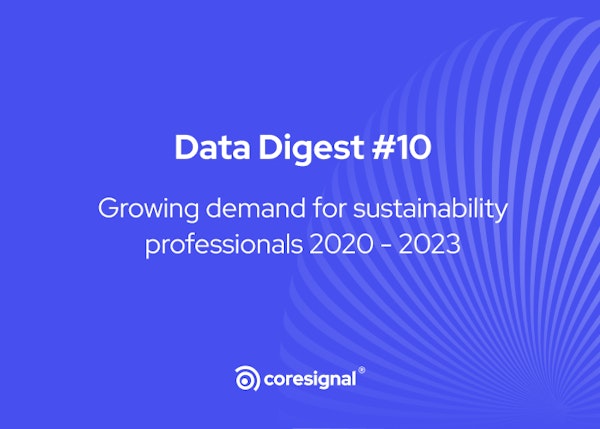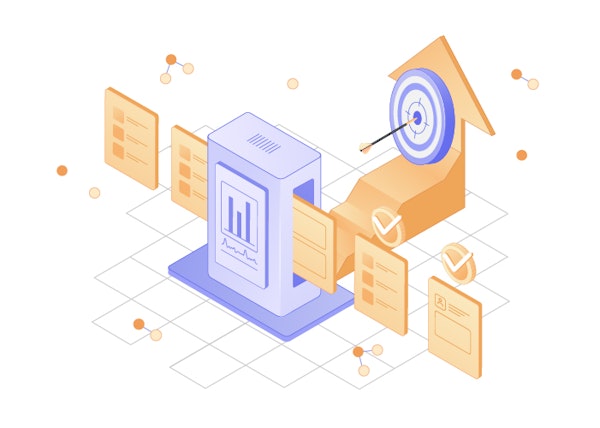Professional network data
Leverage our top B2B datasets
Job posting data
Get access to hundreds of millions of jobs
Employee review data
Get data for employee sentiment analysis
Clean dataNEW
Enhanced professional network data
Employee data
Get data on global talent at scale
Funding data
Discover and analyze funding deals
Firmographic data
Unlock a 360° view of millions of companies
Technographic data
Analyze companies’ tech stacks
BY INDUSTRY
MOST POPULAR USE CASES
Investment
Leveraging web data for informed investing
HR tech
Building or enhancing data-driven HR tech
Sales
Supercharging your lead generation engine
Marketing
Transforming marketing with web data
Market research
Conducting comprehensive market research
Lead enrichment
Use Coresignal’s data for enrichment
Talent analytics
Analyze talent from multiple perspectives
Talent sourcing
Comprehensive talent data for recruitment
Investment analysis
Source deals, evaluate risk and much more
Target market analysis
Build a complete view of the market
Competitive analysis
Identify and analyze competitors
B2B Intent data
Lesser-known ways to find intent signals
BY INDUSTRY
MOST POPULAR USE CASES
Investment
Leveraging web data for informed investing
HR tech
Building or enhancing data-driven HR tech
Sales
Supercharging your lead generation engine
Marketing
Transforming marketing with web data
Market research
Conducting comprehensive market research


Coresignal
October 13, 2021
Data redundancy refers to storing the same data in more than one place. This happens in nearly every business that doesn’t use a central database for all its data storage needs. As you move away from siloed data, it is highly likely that you will come across redundant data. Duplicated information does not only make your database inconsistent but can also significantly skew your data insights, leading to less efficient or unsuccessful business decisions. The following sections introduce you to a quick guide to data redundancy and how you can avoid it.
What is data redundancy?
Data redundancy refers to storing the same data in multiple separated places. For instance, you store all of your sales data, including each customer’s sale and their address. In this list, the same address will appear repeatedly in the case of regular customers, leading to redundant data if you want to identify all of your customers, for instance.
In a similar way, businesses may retain employee records in the HR department; separately, the same data may repeat in the local office. Also, another common occurrence is when backing up data periodically – in this case, you are highly likely to end up with lots of redundant or repeating data.
Why is data redundancy a problem?
When you are unaware of data redundancy, your organization can be at risk. Firstly, since this implies repetition of data, data redundancy includes the same data being present in multiple formats or tables. In turn, this means data analysis becomes irrelevant and biased, so you cannot use your data to make data-driven decisions.
Apart from unreliable, inconsistent corporate-wide datasets, data redundancy could easily lead to data corruption. In other words, storing the same data fields repeatedly in your system could lead to errors and corrupted files; when trying to open those, you won’t be able to as you’ll receive a system message stating that your file is corrupted and cannot be accessed.
Another intuitive drawback is database size. When storing the same data repeatedly, your database will inevitably become larger and more complex. In turn, you will have a more challenging time extracting insights from the information, struggling with increased loading times, and making you and your employees spend significantly more time trying to do your daily tasks.
Finally, a larger and more complex database is more expensive due to storage fees. This can be a considerable burden in the case of a company trying to reduce its overheads and boost profits.
How to reduce data redundancy
If your database contains unintentional redundant data, there are several things you can do to reduce data redundancy.
Database design
If you aim to reduce data redundancy within your in-house database, it should be noted that you need to start from the database design. For instance, make sure you don’t have the same field in multiple tables; alternatively, you should not keep the same data in different formats.
If your company uses external data, the method of collecting and preparing it is extremely important to avoid redundancy. One of the quickest and most reliable ways is to use a data provider which can fulfill your data needs while providing all the information in an accurate, consistent, and reliable format.
Clean your database periodically
A common way of creating redundant data is when you transfer your information to a new database, format, or system. If you migrate to a new system, it is important to delete the old records that would otherwise eat up storage space and increase your costs.
Also, you should delete old databases that you do not use; it is important to keep in mind that intentional data backup is recommended. However, you should implement a backup schedule.
If you want to save time by mitigating these tasks and still have fresh and accurate data, you can always rely on Coresignal. We take care of the quality and accuracy issues for you.
How to avoid data redundancy?
In most cases, data redundancy is unavoidable. Nonetheless, there are a few things you can do to eliminate such entries.
Regular data checking
To avoid data redundancy and to find repetitive entries, it is important to establish a rigid schedule for data checking. Periodically, you should dive deeply into your data and databases. Transactional information has the highest chance to become repetitive, but you should check the entire database from time to time, running a check to identify identical data.
Identifying the cause
If you repeatedly encounter redundant data, you should find the root of this problem. In some cases, your software and applications might recreate data. In the case of in-store programs, changing them to eliminate this problem can be quite straightforward. Nonetheless, asking your in-house team to look into code and software architecture can be costly and time-consuming; yet, this will save data storage expenses in the future, so the effort is well spent.
In the case of third-party applications that require or create redundant data, you may want to find alternative solutions. If possible, try to run only software or code that points to one source of data.
Data integration
Finally, many companies have multiple data storing systems. For instance, you may have a human resources database, a departmental database, and a local office database. These will contain the same data, increasing your storage costs.
Data redundancy when using different systems can be solved through data integration. In other words, you merge all of these separate datasets into a single system. It may be time-intensive, but this process will help you retain only accurate, up-to-date data free of errors or repetitions. Having a single database for all of your data needs also helps you save time on routine checks and maintenance.

Is data redundancy good or bad?
Data redundancy is not necessarily negative – yet, in order to have benefits, redundant data should be created and stored in an organized way as a part of your intentional daily operations. When you decide to store redundant data, you may benefit from several advantages.
Firstly, redundant data represents a backup method of your information. Storing the same data in the cloud or locally (in a computer system) comes with an extra layer of protection in case your original storage method fails. For instance, redundant data in this case could be part of your company’s disaster recovery plan.
Next, redundant data, or information stored on multiple systems, has the benefit of wider availability. For example, employees could have improved access to the data they need since it is stored on multiple systems. This is extremely important for customer service, given the increasing demand for quick, prompt, and efficient solutions.
Finally, storing the same data in multiple sources allows you to compare your information and ensure it is correct and accurate. This enhanced data reliability is ideal when handling suppliers, customers, your staff, and more.
It’s important to acknowledge that data redundancy is beneficial only when it is intentional. If your database contains redundant information, this has many disadvantages for your business and the quality of your decision-making process.
Summary
All in all, redundant data refer to the same information stored in various formats, tables, or systems. Apart from increasing your data storage costs, data repetition is unreliable when it is unintentional since you will most likely use it to make business decisions.
It is important to run checks to delete repeating data, but intentional data redundancy has numerous advantages, too, including enhanced protection. You can also use backups as part of your disaster recovery plan.
Finally, if your company has different databases, it is recommended to opt for data integration to combine all of the data sources into only one database. This will be easier to maintain, cost less, and it ensures that you have access to all the key data for decisions by accessing only one system.
Don’t miss a thing
Subscribe to our monthly newsletter to learn how you can grow your business with public web data.
By providing your email address you agree to receive newsletters from Coresignal. For more information about your data processing, please take a look at our Privacy Policy.

Related articles

Sales & Marketing
It’s a (Data) Match! Data Matching as a Business Value
With the amount of business data growing, more and more options to categorize it appear, resulting in many datasets....
Mindaugas Jancis
April 09, 2024

Data Analysis
Growing demand for sustainability professionals 2020 - 2023
Original research about the changes in demand for sustainability specialists throughout 2020-2023....
Coresignal
March 29, 2024

Data Analysis
Refined Data as a High-Value, Low-Maintenance Option
Raw data refinement is a vital step before delving into the analysis. But should all companies do this by...
Coresignal
March 28, 2024